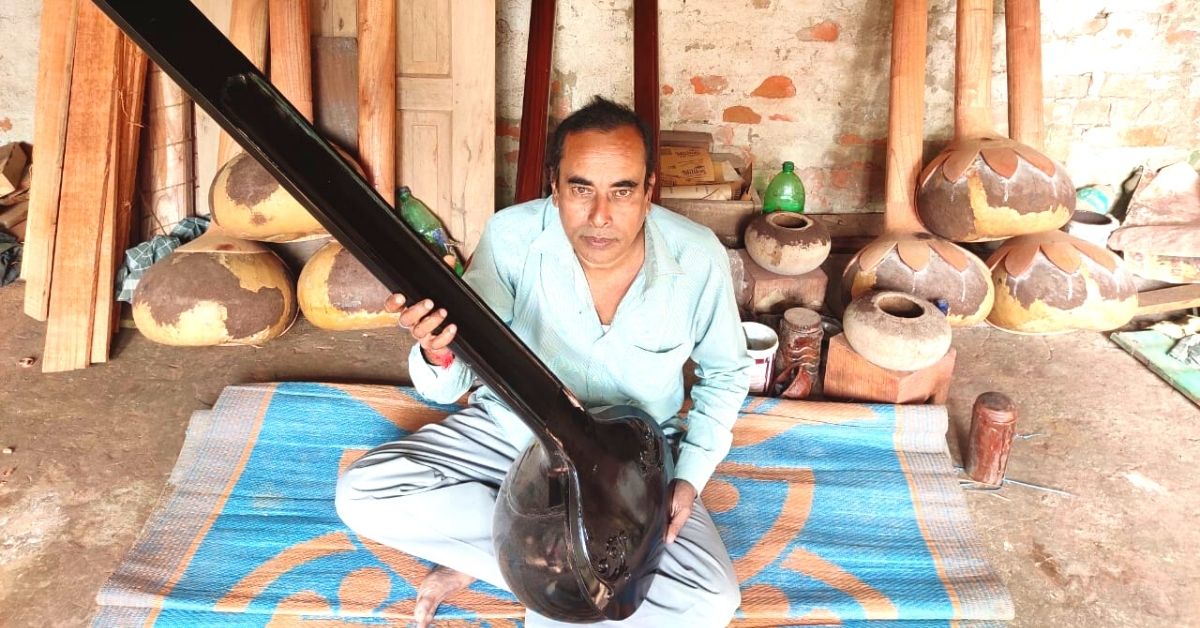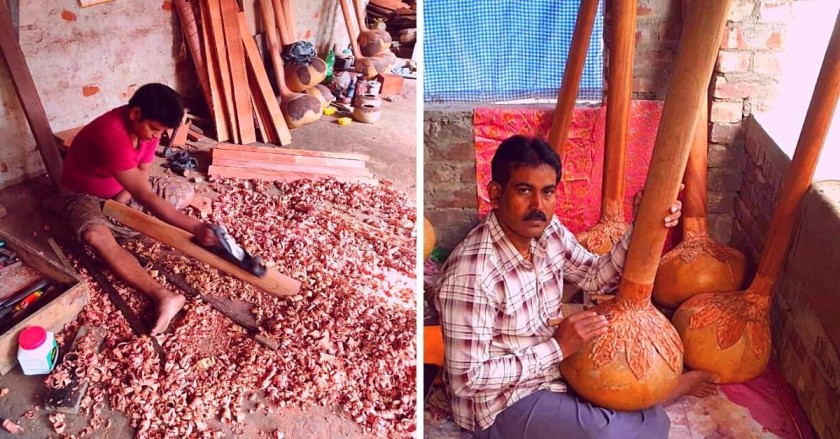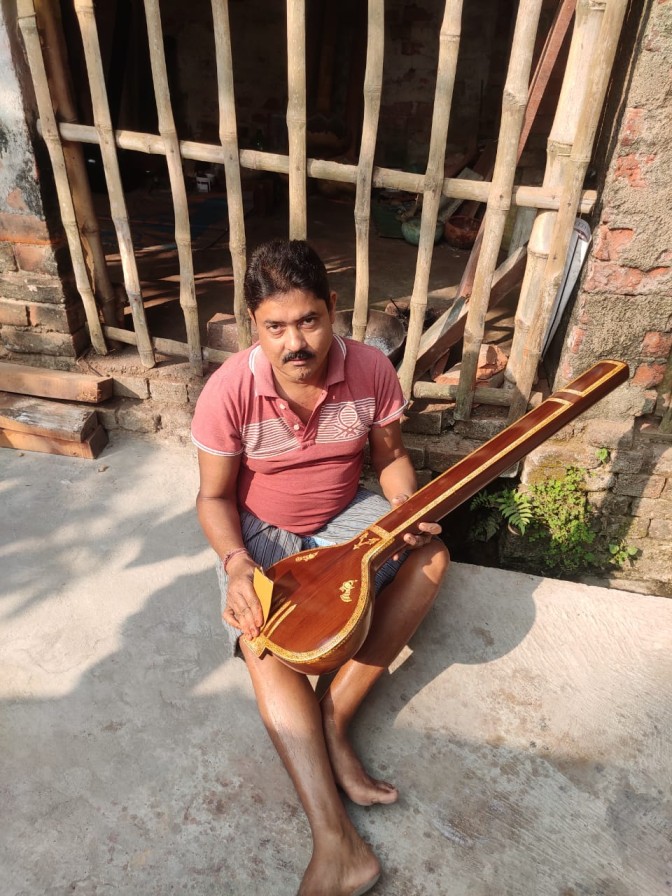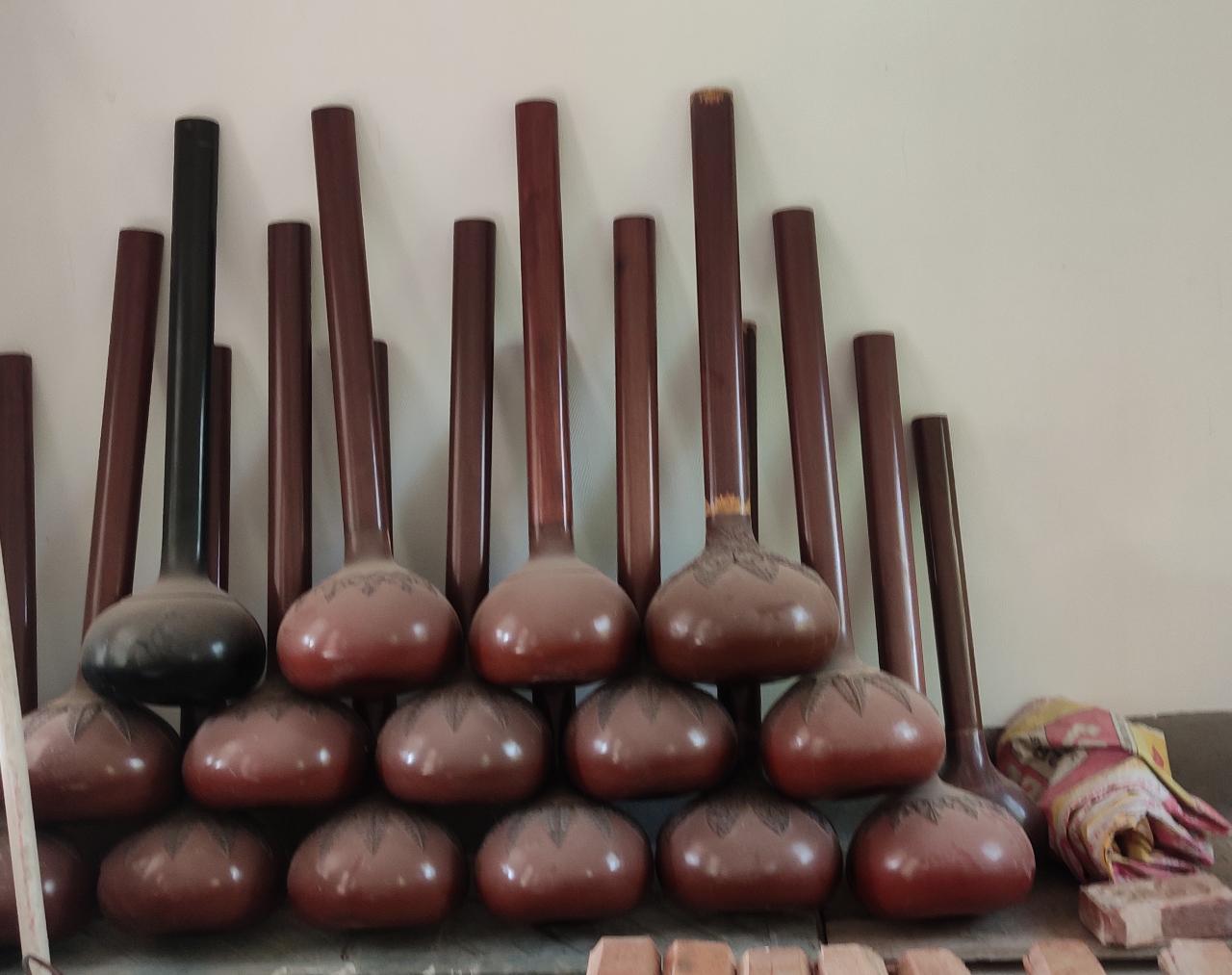With Sheer Passion, Daily Wager Turned Bengal Village Into a Sitar-Making Hub
Tarapada Halder from West Bengal’s Dadpur village has taught sitar manufacturing to 1,000 craftsmen, many of whom have now started their own businesses.

Despite the freezing temperatures of West Bengal’s Dadpur village and lack of sunlight, a couple of men, wrapped in shawls, are intently working in different corners of the Tarapada Sitar House at 6 am.
Surrounded by materials like lao (bottle gourd), toona wood, cellulite paper and bamboo splinters, their work to make a fine sitar is accurately driven by clockwork.
The man with glasses is carving intricate patterns of golap pata (rose plant leaves) on the sitar gourd while humming to the tunes of bodhu kon alo. Sitting diagonally opposite him is a senior artisan, who is playing the same tune on a newly-made sitar. Meanwhile, another artisan is placing bamboo splinters inside the sitar’s hollow structure to keep the inner layer of the sitar gourd stable.
The scene is something out of an art film — the flakes from wooden carvings settle on the floor, sympathetic strings entwine on an artisan’s palm and the bold red paint comfortably slides on the instrument’s neck.

These artisans don’t hold a bachelor’s degree nor have they undergone any formal training in music, yet their knowledge on differentiating between an ordinary sitar and a high-quality one is phenomenal.
This is all thanks to years of strenuous hard work and an extraordinary commitment towards the process of making sitars, and of course, their guru — Tarapada Halder.
The late Tarapada, fondly known as ‘Tara babu’, is the man behind making this small village of Dadpur one of the prime manufacturing sitar hubs of India.
His passion for making sitar and empowering the other villagers by training them, starting from the 1960s, has improved the overall financial situation over the years.
According to his son, Shyamal, who took over the business in 1990, Tarapada has taught around 1,000 craftsmen, many of whom have gone on to start their own business.
The sitars made by his disciples are mainly sold to vendors in Varanasi, Kolkata, Mumbai and Lucknow. From here, they are rebranded and further sold to customers across India and the world.
But the man behind it all came from a past filled with struggles.
A Wage Worker’s Humble Beginnings

Tarapada lost his father when he was barely five and the family slipped into poverty. His mother took up menial jobs at construction sites and people’s houses. Tarapada was forced to grow up fast.
At the tender age of 8, his hands were lifting bricks instead of books. At 16, he migrated to Kolkata with a hope to improve his condition. Little did he know the short trip to the city of the joy would be life-changing.
After working at a tea stall in Girish Park for some months, he joined the Radha Krishna Sharma and Co, a music company. As a wage worker, he earned Rs 2 daily. It was here he was introduced to sitar properly.
“Seeing musicians handle the instrument ignited a curiosity in my father’s mind. He learnt about the parts of the sitar and often helped in glueing them together. In no time, he picked up the basics of sitar manufacturing. His passion was such that he moved to Lucknow in his 20s to learn the karigari from the experts. He even left behind his new bride in Dadpur. For almost a year, my mother didn’t know where he had gone. Eventually, she moved to Lucknow where I and my siblings were born. We stayed there for nine years until baba perfected his craft and then moved back,” Shyamal tells The Better India.
Empowering Villagers & Establishing A Legacy

One of the major reasons why Tarapada returned home, says Shyamal, was to impart his expertise and financially uplift the families. Majority of the people in the village were earning Rs 2 for their excruciating work on manufacturing Mangalorean tiles.
From taking free workshops for villagers to hiring some for setting up the business, Tarapada passed down his knowledge to hundreds of people over the next five decades.
Shyamal was one of his earliest, and probably his youngest, student.
“Since baba manufactured the instruments inside our house premises, I would sit with him after school and observe the process. It was nothing short of magic. I was astonished to see how calabash took the shape of sitar’s beautiful base. Watching the workers carve a piece of wood into a leaf was my favourite part. I started with sticking the strings,” recalls Shyamal.
Shyamal was not the only student of Tarapada who actively started making sitars at 15. Ghulam Rasol was another devoted disciple, who was, interestingly enough, a second generational student of the guru.
Ghulam spent nearly a decade honing the craft from Tarapada before opening his own sitar manufacturing business. Today, he supplies nearly 80 sitars every month to wholesalers in Mumbai, Bengaluru and Chennai.

“Tara babu was the best teacher I could get. His unmatched skills, patience to teach and being assertive about perfection made me what I am today. He never took any short cuts and made each piece with the utmost affection. My son also learnt from him today both of us manage the business,” Ghulam, who is now in his 60s, tells The Better India.
Like Ghulam, there are close to 15 families who are independent instrument makers. Along with the sitar, they also supply other string instruments like tanpuras, and travel sitars (which have a flat sound box or toomba), vina and santur.
Each sitar fetches anywhere between Rs 5,000 to 15,000 depending on the type of wood used in its making. For instance, a sitar made from toon wood, which is generally used to make furniture and ships, is priced at Rs 12,000 and one made of segun (teak) costs much more.
At this point, Shyamal is quick to mention that these prices are for the vendors who eventually sell the sitars at much higher rates. Since they already have an established market and a brand name, they take the lion’s share of profit. “But, even today, we do not get fair prices,” he adds.
For Shyamal, carrying forward his father’s hard-earned legacy and preserving the craft is more important than these financial constraints. It is no wonder that he was not deterred one bit when his brother quit the business and chose another profession.
To make a Sitar

Complex, tedious and meditative — these are three words Shyamal uses to describe the process that can take days and sometimes weeks.
“The base of the sitar is made from a hard-shell gourd and toona wood. The gourd weighing up to 30 kilos is cut and soaked in water for 8-10 hours. Then, it is kept under the sun for nearly a month till the moisture completely evaporates. The sun-drying process makes the shell sturdy. This step is very crucial as it determines the overall quality of the sitar,” explains Shyamal.
Once the gourd is ready, it is cut open in half and then the long panels are carved out of wood. The two are glued together and the gourd’s neck is covered with a wooden patch. Craftsmen engrave exquisite leaves on wooden pieces that are then attached to the base of the sitar. In the final leg, the gigantic piece is painted, scrubbed and polished.
After the sitar is ready, the artisans play the instrument to test it. They use their legs to play the strings and because it is untouched and sharp, they often cut themselves.
Even though the entire procedure is time-consuming and labour intensive, Shyamal’s happiness after each piece is made knows no bounds.
With their sincerity and honesty towards their craft, people like Shyamal and his father Tarapada are hard to find today. They are the true but lesser-known gems of our country that need to be celebrated.
Image source: Shyamal Halder
You can reach Shyamal Halder at +91 91633 34003
Edited by Yoshita Rao
If you found our stories insightful, informative, or even just enjoyable, we invite you to consider making a voluntary payment to support the work we do at The Better India. Your contribution helps us continue producing quality content that educates, inspires, and drives positive change.
Choose one of the payment options below for your contribution-
By paying for the stories you value, you directly contribute to sustaining our efforts focused on making a difference in the world. Together, let’s ensure that impactful stories continue to be told and shared, enriching lives and communities alike.
Thank you for your support. Here are some frequently asked questions you might find helpful to know why you are contributing?


This story made me
- 97
- 121
- 89
- 167










